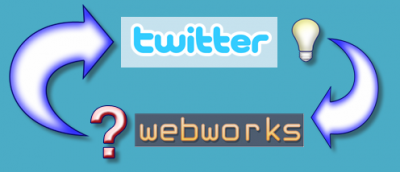Twitter Part II –- One Step Deeper

Earlier this week I asked how others are using Twitter in their documentation and branding strategies. Alan Porter at WebWorks wrote me with details, saying:
As you know we have a branded Twitter account (webworks_com) that we use for product announcements, information on speaking engagements, webinars and just general company updates. We also have a hashtag set up for information related to our annual RoundUp users conference.
We are also encouraging our partner companies, and consultants that we work with, to set up Twitter accounts, and several of them have set up accounts and are using them.
We actively follow all the top Tech Doc twitter accounts like yourself, Sarah O' Keefe, Scott Abel, Anne Gentle, Paul Mueller, Alan Houser, etc., as well as any STC region that is on Twitter. We also follow any customers that we know have Twitter accounts.
Several of the WebWorks staff have personal Twitter accounts. The two most active are:
- Me -- I tend to post on my STC related activities, and my freelance writing projects.
- Jennifer Whitley -- Jen posts a lot about social media; she is also a pilot and posts a lot about flying.
There are several other people at WebWorks on Twitter, including the CEO and Support Staff, but as yet they aren't as active.
OK, so how do we use Twitter as part of our documentation strategy?
- Currently we use an RSS feed from Twitter search to be notified of anyone asking questions about the product. When that happens, we respond by Twitter giving them a link to either our documentation wiki or our Help Center wiki as needed.
- We tweet about updates and new topics added to the wikis on Twitter.
- We tweet about technical blog posts. By the way, we just launched a new blog site at http://blogs.webworks.com.
We are considering doing some prototype work on the following:
- Integrating the Twitter feed directly into the documentation wiki based on hashtags and RSS.
- Having recent changes to the wikis automatically generate a Tweet.
- Have the WebWorks Twitter account feed directly into the product online help for instances where the install is connected to the internet.
As I said these three are just conceptual ideas at the moment, and we are doing some experimental work around them. I'm also talking to a couple of other companies that are looking at integrating Twitter (or social media in general) with their corporate publishing strategy.
I'm impressed at the extent that WebWorks incorporates Twitter into their work, especially their use of hashtags to identify different areas of their documentation.
I was about to post Alan's response when I saw a tweet from Dan Maurer, a technical writer in a rhetoric and professional writing program, saying he might write a masters thesis on Twitter and technical communication. I asked Dan what he thought of WebWorks' use of Twitter.
Dan thinks Webworks' use of Twitter focuses on the user, which is a good thing. And services that send Twitter direct messages when a wiki entry is updated are useful, especially for people who prefer this type of communication.
However, Dan fears that this is "just another method of getting word out to the user. A new way, and one that's useful, but not really different from an e-mail list, blog, or RSS feed."
So exactly what is the value of Twitter, in contrast to other means of communication? What unique quality does Twitter bring to the table? Dan lists three unique characteristics of Twitter communication:
- Low attention threshold. (140 characters)
- Mobile capability.
- Networking. Our @ conversations are public ... that's how I find new people to follow.
But if given the option to subscribe to Twitter, RSS, or email to stay updated about a product, Dan says he would choose RSS, because it keeps his inbox free. "I use Twitter for conversations with interesting people, not to learn about the newest gadgets. Again, that's what RSS is for," he says.
I agree with much of Dan's analysis. If one technology already fulfills a need, there's little value in duplicating it with another technology. However, given the increasing amount of information we must sort through daily, the limitation of 140 characters per message is appealing.
About Tom Johnson

I'm an API technical writer based in the Seattle area. On this blog, I write about topics related to technical writing and communication — such as software documentation, API documentation, AI, information architecture, content strategy, writing processes, plain language, tech comm careers, and more. Check out my API documentation course if you're looking for more info about documenting APIs. Or see my posts on AI and AI course section for more on the latest in AI and tech comm.
If you're a technical writer and want to keep on top of the latest trends in the tech comm, be sure to subscribe to email updates below. You can also learn more about me or contact me. Finally, note that the opinions I express on my blog are my own points of view, not that of my employer.
